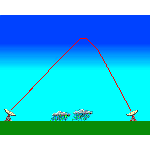
Since the antenna and preamplifier are located outdoors and at a significant distance from the workshop where the rest of the instrumentaion is located the VLF signals must be conveyed over that distance with minimal loss and degradation. It doesn't hurt if it can be accomplished cheaply. A balanced, twisted pair is a good solution for this application and enjoys wide use in many other applications. POTS (Plain Old Telephone Service), residential Internet over high speed DSL (Digital Subscriber Line), and Ethernet all operate with twisted, copper pairs of wire. A critical element in making this scheme work is to reduce the source and load impedances enough to ensure good high frequency performance. This is easily accomplished using readily available audio transformers, one at each end of the cable.
An audio transformer from Radio Shack (Part# 273-1380) was selected for testing. In order to evaluate the performance of this scheme the test circuit displayed to the right was assembled. In it a signal generator with low output impedance delivers a selected sine wave to the 1kOhm side of one transformer. The 8Ohm side of the same transformer is connected, either directly or through one pair of 8m of common four-wire, unshielded household telephone cable, to the 8Ohm side of a second identical transformer. The 1kOhm side of the second transformer is terminated with a 1kOhm resistor. A Digital Multi Meter (DMM, Radio Shack Part# 22-812) is used to measure the AC voltage at the 1kOhm sides of both transformers.
At each frequency the signal generator's output is adjusted to a particular voltage (5.0Vac in this case) and the AC voltage is measured across the 1kOhm terminating resistor using the same DMM. The entire set of measurements is repeated with a direct connection between the transformers and with a length of cable as noted above. The ratios of voltages are converted to decibels (dB) and plotted as shown in the second figure.
The results show that there is a certain amount of loss created by the pair of transformers, a fraction of a decibel at low frequencies and there is actually some gain at higher frequencies, peaking at around 60kHz. This is not a violation of the Law of Conservation of Energy - voltage is not energy. The observed "gain" is strictly voltage gain not power gain. Also noteworthy is the very small loss created by including the cable in the circuit, it is less than one decible over the entire frequency range studied which is quite acceptable. It also indicates that a greater cable length would also work well if it were judged desireable to locate the antenna/preamplifier combination further from the workshop equipment.
